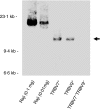Biclonal expansion of T cells infected with monoclonal Epstein-Barr virus (EBV) in a patient with chronic, active EBV infection
- PMID: 12974760
- PMCID: PMC1808841
- DOI: 10.1046/j.1365-2249.2003.02270.x
Biclonal expansion of T cells infected with monoclonal Epstein-Barr virus (EBV) in a patient with chronic, active EBV infection
Abstract
Recent studies have suggested that a high percentage of Epstein-Barr virus (EBV)-infected lymphocytes in peripheral blood of patients with chronic, active EBV infection (CAEBV) is of T cell origin. Although T cells are expanded oligoclonally in CAEBV, it is not clear whether the restricted diversity of T cells arise from immune reaction against EBV-related antigens or from proliferation of EBV-infected cells. We experienced a patient with CAEBV who had biclonal expansion of peripheral blood T cells. We identified clonotypes of these two T cell clones in detail and purified the T cell clones. EBV infected mainly the two T cell clones, whereas the viral loads in peripheral blood cells other than these T cell clones were low or undetectable. The EBV strains infecting the two T cells clones were indistinguishable from each other by a series of genotype analyses of the virus. These results suggest that the two T cell clones infected with the same monoclonal EBV proliferated in peripheral blood of the patient.
Figures




Similar articles
-
Restricted diversification of T-cells in chronic active Epstein-Barr virus infection: potential inclination to T-lymphoproliferative disease.Am J Hematol. 1999 May;61(1):26-33. doi: 10.1002/(sici)1096-8652(199905)61:1<26::aid-ajh6>3.0.co;2-r. Am J Hematol. 1999. PMID: 10331508
-
Clonal origin of Epstein-Barr virus (EBV)-infected T/NK-cell subpopulations in EBV-positive T/NK-cell lymphoproliferative disorders of childhood.J Clin Virol. 2011 May;51(1):31-7. doi: 10.1016/j.jcv.2011.01.014. Epub 2011 Mar 5. J Clin Virol. 2011. PMID: 21377409
-
Pathogenesis of chronic active Epstein-Barr virus infection: is this an infectious disease, lymphoproliferative disorder, or immunodeficiency?Rev Med Virol. 2006 Jul-Aug;16(4):251-61. doi: 10.1002/rmv.505. Rev Med Virol. 2006. PMID: 16791843 Review.
-
Differential cellular targets of Epstein-Barr virus (EBV) infection between acute EBV-associated hemophagocytic lymphohistiocytosis and chronic active EBV infection.Blood. 2001 Sep 15;98(6):1882-8. doi: 10.1182/blood.v98.6.1882. Blood. 2001. PMID: 11535525
-
The role of virus-specific CD4+ T cells in the control of Epstein-Barr virus infection.Eur J Cell Biol. 2012 Jan;91(1):31-5. doi: 10.1016/j.ejcb.2011.01.007. Epub 2011 Apr 1. Eur J Cell Biol. 2012. PMID: 21458882 Review.
Cited by
-
Chronic Epstein-Barr virus-related hepatitis in immunocompetent patients.World J Gastroenterol. 2006 Sep 21;12(35):5711-6. doi: 10.3748/wjg.v12.i35.5711. World J Gastroenterol. 2006. PMID: 17007027 Free PMC article.
References
-
- Okano M. Overview and problematic standpoints of severe chronic active Epstein–Barr virus infection syndrome. Crit Rev Oncol Hematol. 2002;44:273–82. - PubMed
-
- Kimura H, Hoshino Y, Kanegane H, et al. Clinical and virologic characteristics of chronic active Epstein–Barr virus infection. Blood. 2001;98:280–6. - PubMed
-
- Maia DM, Peace-Brewer AL. Chronic, active Epstein–Barr virus infection. Curr Opin Hematol. 2000;7:59–63. - PubMed
-
- Maeda A, Wakiguchi H, Yokoyama W, et al. Persistently high Epstein–Barr virus (EBV) loads in peripheral blood lymphocytes from patients with chronic active EBV infection. J Infect Dis. 1999;179:1012–5. - PubMed
-
- Kasahara Y, Yachie A, Takei K, et al. Differential cellular targets of Epstein–Barr virus (EBV) infection between acute EBV-associated hemophagocytic lymphohistiocytosis and chronic active EBV infection. Blood. 2001;98:1882–8. - PubMed
Publication types
MeSH terms
LinkOut - more resources
Full Text Sources
Other Literature Sources

